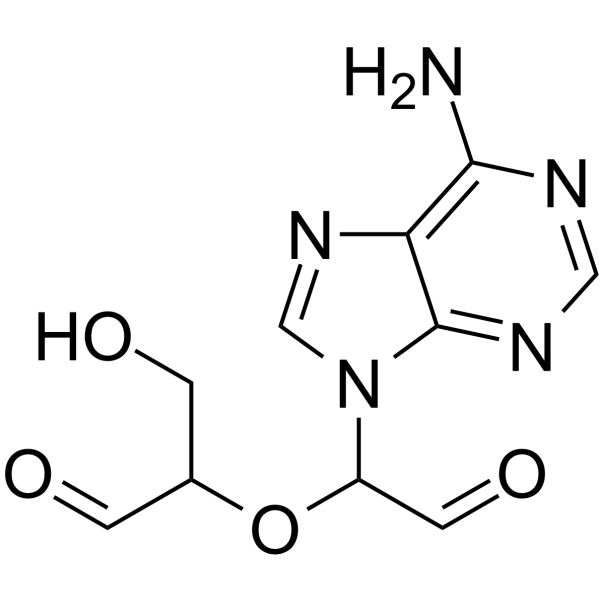
Adenosine Dialdehyde (ADOX)
CAS No. 34240-05-6
Adenosine Dialdehyde (ADOX)( Adenox | Adenosine, periodate oxidized | Periodate-oxidized adenosine | Adenosinedialdehyde )
Catalog No. M27526 CAS No. 34240-05-6
Adenosine dialdehyde is a purine nucleoside analogue. Adenosine dialdehyde is a potent inhibitor of S-Adenosylhomocysteine hydrolase (SAHH) (Ki=3.3 nM). Adenosine Dialdehyde exhibits potent anti-tumor activity in vivo.
Purity : >98% (HPLC)
 COA
COA
 Datasheet
Datasheet
 HNMR
HNMR
 HPLC
HPLC
 MSDS
MSDS
 Handing Instructions
Handing Instructions
| Size | Price / USD | Stock | Quantity |
| 5MG | 45 | Get Quote |


|
| 10MG | 58 | Get Quote |


|
| 25MG | 86 | Get Quote |


|
| 50MG | 149 | Get Quote |


|
| 100MG | 224 | Get Quote |


|
| 200MG | 336 | Get Quote |


|
| 500MG | 565 | Get Quote |


|
| 1G | Get Quote | Get Quote |


|
Biological Information
-
Product NameAdenosine Dialdehyde (ADOX)
-
NoteResearch use only, not for human use.
-
Brief DescriptionAdenosine dialdehyde is a purine nucleoside analogue. Adenosine dialdehyde is a potent inhibitor of S-Adenosylhomocysteine hydrolase (SAHH) (Ki=3.3 nM). Adenosine Dialdehyde exhibits potent anti-tumor activity in vivo.
-
DescriptionAdenosine dialdehyde is a purine nucleoside analogue. Adenosine dialdehyde is a potent inhibitor of S-Adenosylhomocysteine hydrolase (SAHH) (Ki=3.3 nM). Adenosine Dialdehyde exhibits potent anti-tumor activity in vivo.(In Vitro):Adenosine dialdehyde suppresses MNB cell replication in tissue culture (1.5 μM, 50% inhibition) .(In Vivo):Adenosine dialdehyde (subcutaneous injection; 1.5-2.5 mg/kg; two 7-day periods interspersed by a 7-day drug free interval( minipump infusion))increases mean life span 80% in diluent treated controls (controls, 21.3 days; AD treated 38.4 days) in mice. Adenosine dialdehyde (subcutaneous injection; 1.5-2.5 mg/kg; infused over a 7-day period ( minipump infusion)) significantly increases the mean life span of tumor bearing mice from 20.9 days in diluent treated controls to 35.3 days in AD treated animals. Adenosine dialdehyde (subcutaneous injection; 2-3 mg/kg; infused over a 7-day period ( minipump infusion)) does not exhibit any hematopoietic toxicity in mice, and it can significantly suppress murine neuroblastoma tumor growth with little systemic toxicity.
-
In Vitro——
-
In VivoAnimal Model:Adult male A/J mice, weighing 20 to 25 g with MNB cells Dosage: 1.5-2.5 mg/kg Administration:Subcutaneous injection; 1.5-2.5 mg/kg; two 7-day periods interspersed by a 7-day drug free interval (minipump infusion) Result:Significantly suppressed murine neuroblastoma tumor growth.Prolongs the life span of tumor bearing mice.Did not suppress hematopoiesis when administered by steady state infusion.
-
SynonymsAdenox | Adenosine, periodate oxidized | Periodate-oxidized adenosine | Adenosinedialdehyde
-
PathwayOthers
-
TargetOther Targets
-
RecptorTrypsin-like proteasomes|IFN-γ
-
Research Area——
-
Indication——
Chemical Information
-
CAS Number34240-05-6
-
Formula Weight265.225
-
Molecular Formula——
-
Purity>98% (HPLC)
-
SolubilityIn Vitro:?DMSO : 10 mg/mL (37.70 mM)
-
SMILESNc1ncnc2n(cnc12)C(OC(CO)C=O)C=O
-
Chemical Name——
Shipping & Storage Information
-
Storage(-20℃)
-
ShippingWith Ice Pack
-
Stability≥ 2 years
Reference
1.Shadrin N, et al. Serine protease inhibitors interact with IFN-γ through up-regulation of FasR; a novel therapeutic strategy against cancer. Exp Cell Res. 2015 Jan 15;330(2):233-9.
molnova catalog



related products
-
Gnetifolin E
Gnetifolin E is a new resveratrol trimer derivative from Gnetum brunonianum.
-
ATR-101
ATR-101 (PD-132301, Nevanimibe) is a selective and potent inhibitor of ACAT1 with IC50 of 52 nM.
-
β-Alanine methyl est...
β-Alanine ethyl ester is the ethyl ester of the non-essential amino acid β-alanine.



 Cart
Cart
 sales@molnova.com
sales@molnova.com


